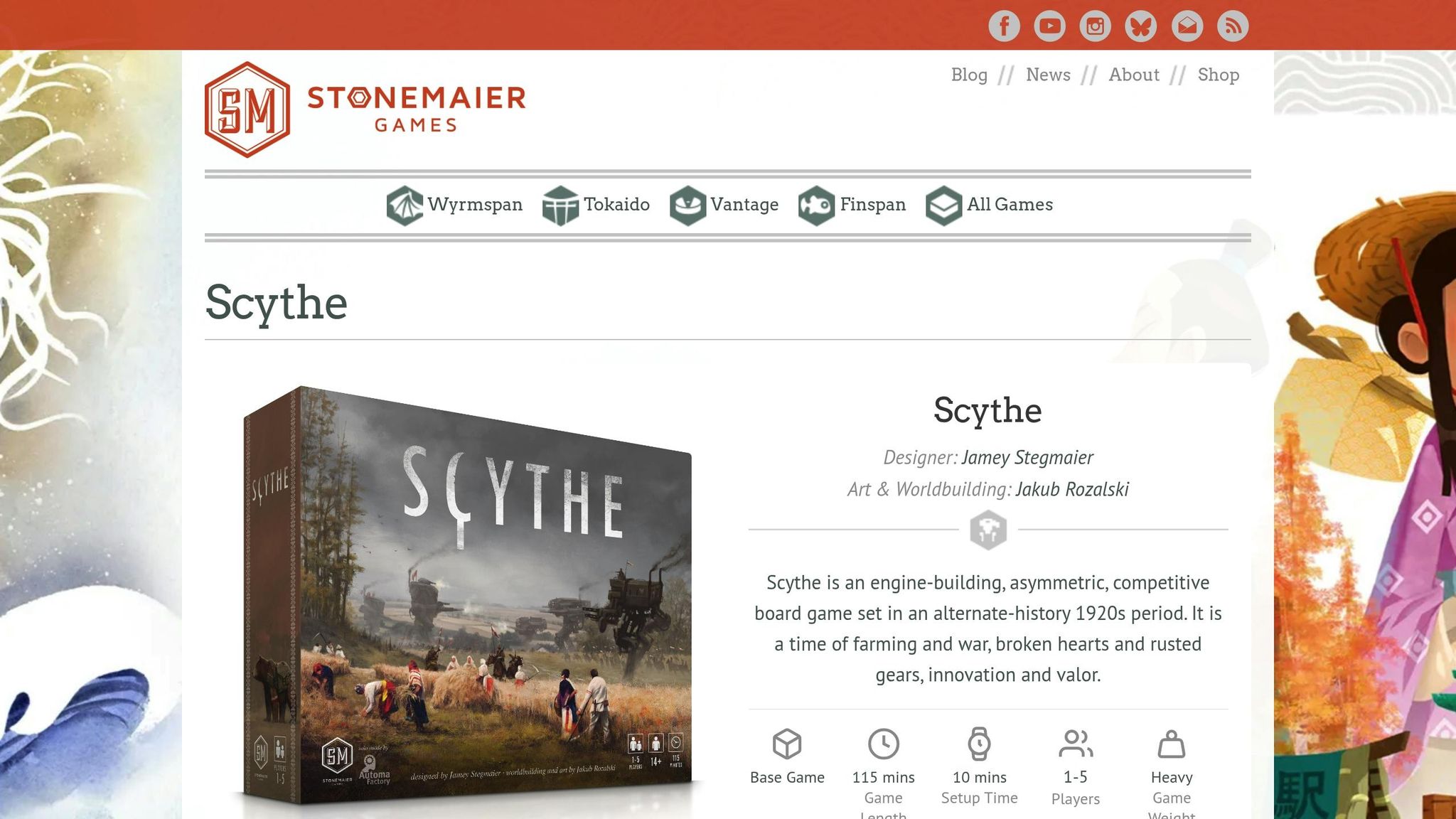Discover the Best Board Games for Every Player

Albion Clan Militant Strategy Explained
The Albion Clan in Scythe excels at controlling territory through a methodical and calculated approach. Their gameplay focuses on establishing strong positions using unique abilities like "Exalt" and "Rally." Here's what you need to know:
- Flags as Territories: Albion can place flags that count as territories during scoring, making it easier to control key areas.
- Combat and Defense: Their "Shield" ability boosts power during battles, while "Rally" allows quick repositioning to flagged zones.
- Territorial Focus: Flags create scoring opportunities and strategic footholds, especially in resource-rich or contested areas.
- Mobility Network: Rally Mechs can move directly to flagged zones, offering flexibility in response to threats or opportunities.
Albion's playstyle contrasts with other clans:
- Saxony emphasizes aggressive combat and disruption.
- Nordic leverages speed to outmaneuver opponents.
- Togawa uses traps to create psychological pressure and control movement.
Albion rewards players who prefer a slower, more deliberate approach, focusing on long-term dominance over quick expansion. However, their limited mobility can be a challenge against faster or more unpredictable opponents. Success hinges on careful resource management and strategic flag placement.
Albion Militant 19 Turns - Bid Game - LIVE Stream - 6/30/20 - Scythe Board Game

1. Albion Clan Militant Strategy
Albion's militant strategy builds on their strong defensive capabilities, turning them into a force that not only holds ground but actively expands their influence. This approach blends aggressive territory acquisition with solid defense, making them a formidable presence on the battlefield.
Combat Effectiveness
Albion's strength in combat comes from their ability to defend and hold key positions. They engage in battles strategically, focusing on securing territories that matter most. As the Iron Harvest Wiki puts it:
"Their military tactics revolve around acquiring and holding territory, strong on the defense and powerful in combat. Once they take territory and plant their flag, they are hard to dislodge." – Iron Harvest Wiki
This careful selection of battles forces opponents to expend significant resources to challenge Albion's fortified positions. By doing so, Albion players ensure their efforts are concentrated on maintaining control over critical areas, setting the stage for long-term dominance.
Territorial Control
Albion's strategy is amplified by their 4 Flag tokens, which act as additional territories during endgame scoring. To maximize their effectiveness, players must carefully choose where to place these flags, balancing immediate tactical advantages with future scoring opportunities.
"This is exemplified by the Albion faction's 4 Flag tokens, each of which counts as an additional territory for endgame scoring to the Albion player if (a) they control the Flag token's territory with a character, mech, worker, or unoccupied structure AND (b) the Flag token is not on a territory adjacent to the Albion home base." – Scythe Rules, page 4
High-value areas like encounter spaces, resource-rich hexes, and chokepoints are ideal for flag placement. Each flag not only adds to Albion's scoring potential but also creates strategic footholds that opponents must navigate around. Flags also enable quicker redeployment, giving Albion the flexibility to adapt to changing battlefield conditions.
Mobility
Albion's flags aren't just for scoring - they also create a mobility network that enhances tactical flexibility. Rally Mechs can move directly to any flagged territory, bypassing obstacles. This allows Albion players to reinforce weak points or launch surprise attacks with ease. The combined power of Connor and Max’s flag-placing abilities, paired with Rally movement, ensures Albion can quickly adapt to threats or opportunities.
Scoring Potential
Albion's militant strategy directly ties territorial control to scoring. Each successfully placed and controlled flag guarantees extra points at the end of the game, making expansion a key to victory. However, maintaining control of flagged territories requires active board presence - whether through characters, mechs, workers, or structures - which further supports Albion's dominance.
Every move in this strategy strengthens Albion’s endgame position, making it a powerful approach for players aiming to maximize the clan’s potential on the battlefield.
2. Saxony Clan Combat Strategy
This section dives into Saxony's bold and offensive approach, contrasting it with Albion's more reserved and fortified tactics. While Albion focuses on holding their ground, Saxony thrives on relentless aggression and calculated disruption.
Combat Effectiveness
Saxony turns every battle into an opportunity for growth. Their strategy relies on swift, unpredictable movements that punch through enemy defenses and throw opponents off balance. By keeping rivals guessing and unable to settle into a rhythm, Saxony gains control over the battlefield, dictating the flow of combat.
Territorial Control
Instead of relying on static defenses, Saxony applies constant pressure to disrupt enemy positions. They challenge key territories, forcing opponents to react and reshuffle their plans. This constant contesting of strategic zones shifts the balance of power and keeps the map in a state of flux, favoring Saxony's dynamic playstyle.
Scoring Potential
Saxony's aggressive tactics not only secure quick victories but also lay the groundwork for a strong mid-game. By rapidly expanding their resources and infrastructure, they open up multiple scoring opportunities. Their sustained offensive approach ensures they remain a dominant force, shaping the battlefield to their advantage as the game progresses.
3. Nordic Clan Mobility Strategy
Nordic thrives on speed and adaptability, leaving behind traditional defensive or overly aggressive tactics. This quick and nimble strategy is the backbone of Nordic's gameplay.
Mobility
Nordic units are unmatched in speed, giving them a clear edge in reacting to changing situations and seizing opportunities.
Their movement bonuses create a snowball effect as the game progresses. Early on, they can position themselves advantageously, and this momentum builds over time. Whether advancing into new territories or retreating from unfavorable engagements, Nordic's superior mobility ensures they dictate the flow of the game. This ability to move with precision isn't just about covering ground - it's a key factor in their combat and territorial strategies.
Territorial Control
Unlike Albion, which relies on holding fixed defensive lines, Nordic adopts a dynamic territorial approach. They excel at capturing key locations quickly, then repositioning before opponents can mount a counterattack. This forces enemies into a reactive stance, always chasing Nordic's movements.
Timing is everything for Nordic. They can sweep into contested areas at critical moments, secure objectives, and disappear before opponents can retaliate. This constant mobility creates a psychological edge, as opponents must always account for Nordic's ability to strike anywhere with little warning.
Combat Effectiveness
When it comes to battle, Nordic prefers precision over brute force. They focus on picking fights where they have the upper hand, concentrating their forces to deliver quick, decisive blows. Instead of getting bogged down in prolonged engagements, they target isolated enemy units and overwhelm them efficiently.
Scoring Potential
Nordic's speed isn't just about movement - it directly enhances their ability to score. They can chase multiple victory paths at once, pivoting between objectives based on the situation.
In the late game, their mobility shines even brighter. Nordic can secure critical objectives or disrupt enemy plans with well-timed, last-minute actions that other clans simply can't match. This late-game adaptability often allows them to turn the tables and claim victory, even when the odds seem stacked against them.
sbb-itb-1ed942f
4. Togawa Clan Trap Strategy
The Togawa Clan thrives on deception and misdirection, using traps to keep opponents guessing while maintaining control of the battlefield. This clan doesn’t rely on brute force but instead focuses on strategic positioning and surprise attacks, turning deception into a powerful tool for territorial play.
Combat Effectiveness
Togawa avoids head-on battles, preferring to lure enemies into disadvantageous situations with their traps. Unlike Albion’s defensive resilience or Saxony’s aggressive assaults, Togawa plays a psychological game, forcing opponents to question every move.
The mere presence of a trap - or the possibility of one - creates mental pressure that can outweigh raw combat strength. Opponents are left wondering if worker placements are genuine or bait for a trap, leading to hesitation and mistakes.
When Togawa does engage in combat, they rely on ambush tactics. They excel at isolating enemy units and striking with concentrated force from unexpected angles. Their combat strength increases significantly when opponents fall into predictable patterns or overlook hidden threats.
Territorial Control
Instead of occupying territory outright, Togawa uses traps to make key areas too dangerous for opponents to approach. A single well-placed trap can influence several hexes, forcing enemies to take longer, less efficient routes.
Togawa’s traps create invisible zones of influence, extending control far beyond the positions of their actual units. By strategically placing traps at bottlenecks or critical pathways, they can control the flow of movement across the map. This tactic is especially effective on maps with natural chokepoints or limited crossing points, as it forces opponents into predictable paths that Togawa can exploit.
Scoring Potential
Togawa’s scoring strategy revolves around timing and surprise. Falling behind early in the game is often part of their plan, as it allows them to set up trap sequences that can turn the tide later on.
Unlike other clans that telegraph their scoring intentions through obvious positioning, Togawa keeps opponents guessing. A single trap might force an enemy retreat while simultaneously opening up multiple scoring opportunities for Togawa. This unpredictability makes them a challenging opponent to counter.
Skilled Togawa players often delay early gains to set up powerful late-game plays. These well-timed combinations can completely shift the momentum of the match, proving that patience and planning are key to their success.
Pros and Cons
When you compare Albion's defensive strategy to the approaches of other clans, it becomes clear how tactical choices can shape the game. Albion's sturdy defense is incredibly reliable, but it comes at the cost of flexibility. Saxony thrives on aggressive expansion, but that same aggression can lead to overextension. Nordic's mobility offers unique tactical options, though it compromises combat power. Meanwhile, Togawa's traps are excellent for controlling movement but require precise timing to be effective. Each clan's strategy demands a unique skill set suited to specific scenarios.
Here’s a quick breakdown of how these factions stack up:
| Faction | Combat Effectiveness | Territorial Control | Mobility | Scoring Potential |
|---|---|---|---|---|
| Albion | High defensive strength, moderate offensive power | Great at holding key areas | Limited due to defensive focus | Consistent, steady gains |
| Saxony | Strong offensive capabilities | Rapid territorial expansion | Decent tactical movement | High early-game scoring |
| Nordic | Moderate combat strength | Flexible in controlling areas | Exceptional terrain mobility | Sporadic scoring bursts |
| Togawa | Ambush-focused combat | Hidden control through traps | Strategic positioning is key | Unpredictable late-game scoring potential |
Albion's strengths shine when you can secure valuable defensive positions early on. Their ability to endure repeated attacks makes them perfect for holding bottlenecks or resource-heavy areas that other players will inevitably contest. However, this strategy demands patience and careful management of resources, as you might have to forgo early scoring opportunities to set up for long-term dominance.
That said, Albion's defensive edge has its vulnerabilities. Nordic forces, with their unmatched mobility, can bypass Albion's defensive lines entirely, gaining access to resources and routes that your strategy might not cover. Togawa, on the other hand, can use traps to manipulate Albion’s units into poor positions, neutralizing their defensive advantages.
One of Albion's key benefits is that their defensive positions require fewer resources to maintain once established. In contrast, Saxony’s aggressive playstyle demands constant resource investment to sustain its momentum. This makes Albion a solid choice for players who prefer a long-term, calculated approach over Saxony's high-risk, high-reward strategy.
Conclusion
Albion's approach to gameplay is built on a strong defensive strategy that rewards patience and careful planning. While factions like Saxony thrive on aggressive expansion, Nordic leverages mobility, and Togawa excels with strategic traps, Albion's true strength lies in its ability to secure critical positions and withstand prolonged assaults.
The key to mastering Albion is knowing when to capitalize on their defensive advantages. In 3-4 player games, Albion shines in contested territories, where their ability to hold key resources can provide a steady edge throughout the match. However, in 5-6 player games, the crowded board can expose Albion's limited mobility, making it harder to adapt to fast-moving threats.
The board layout also plays a major role in Albion's effectiveness. Maps featuring natural chokepoints, bottlenecks, or centralized resource clusters favor Albion's territorial control style. On the other hand, open boards with multiple pathways can render their defenses less effective, as mobile factions like Nordic can easily maneuver around their strongholds.
Matchups with specific factions further highlight Albion's strengths and weaknesses. For example, Nordic's high mobility allows them to bypass Albion's defenses, striking where they’re least prepared. Meanwhile, Togawa's trap-based tactics can disrupt Albion's carefully planned setups, making it difficult to maintain control over key areas.
Albion's strategy is best suited for players who enjoy methodical, long-term planning rather than quick tactical shifts. Success with Albion requires precise resource management and thoughtful positioning from the very beginning. Players who can anticipate the flow of the game several moves ahead will find Albion's slower, deliberate playstyle highly rewarding. However, newer players might find Albion challenging due to its reliance on planning and its slower pace compared to more aggressive factions.
For those who value defense and control over rapid expansion, Albion offers a reliable path to victory - one that rewards patience and a strategic mindset.
FAQs
How do Albion's flags contribute to scoring and territorial control in Scythe?
Albion's flags add an interesting twist to scoring and strategy. Placing a flag on a territory doesn’t automatically give you control of it, but it does add 1 extra point to that space during end-game scoring. To actually claim the flagged territory as yours, you’ll need to have one of your units stationed there.
Once a flag is placed, it’s there to stay - you can’t move or remove it. This permanence makes flags a powerful tool for locking in key areas and boosting your score, especially when combined with smart unit placement near your home base or in nearby territories.
What challenges does Albion face against highly mobile factions like Nordic?
Albion faces challenges when up against mobile factions like Nordic due to their speed and agility. Nordic's ability to expand territory quickly and respond to threats with ease makes it tough for Albion to maintain control over critical areas or compete effectively.
On top of that, Nordic's knack for repositioning troops with flexibility often leaves Albion's slower, more methodical approach at a disadvantage, especially in high-pressure, fast-moving situations.
When is Albion's defensive strategy most effective in Scythe?
Albion’s defensive approach in Scythe thrives when opponents are unable to make multiple consecutive moves, which limits their ability to launch sustained attacks. By prioritizing control of critical territories and holding a solid defensive stance, Albion can discourage opponents from engaging and secure dominance through superior positioning on the board.
This strategy is ideal for players who prefer a careful, territory-focused style of play. It works especially well in games where opponents adopt a more cautious approach, giving Albion the opportunity to leverage its defensive strengths and strategic placement effectively.






